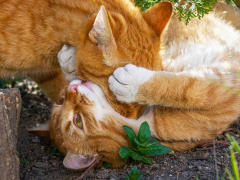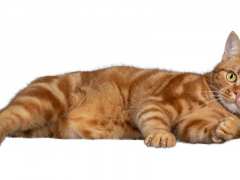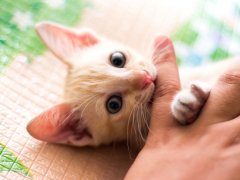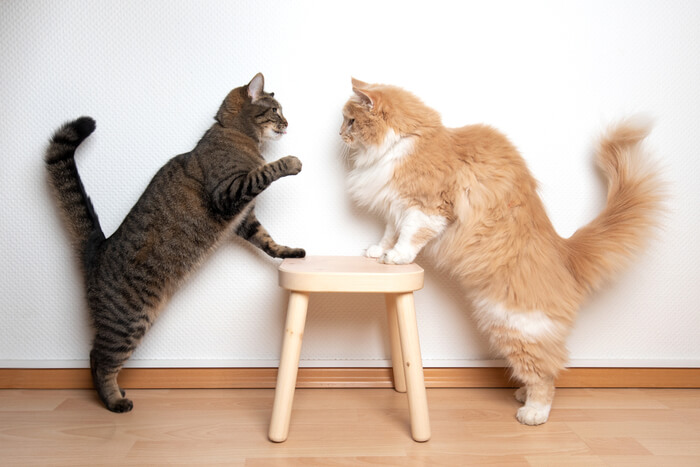
Are you trying to figure out if your cats are playing or fighting during wrestling matches? Cat behavior can be hard to interpret, particularly when there is a mix of ages, breeds, temperaments, and unrelated cats living in one household.
This article will help you distinguish between a play date and a catfight, and how to encourage harmonious living in multi-cat households.
The Social Affiliation of Cats
There is a substantial body of evidence that, although domestic cats are solitary animals and capable of living alone, they also form social bonds. Whether in high-density colonies or in groups of related individuals, cats maintain coherence by creating a group odor via allogrooming/allorubbing.
Moreover, affiliated cats are less likely to exhibit overt aggression toward each other as long as there are sufficient environmental resources.
Likewise, cats socialized together during their formative kitten years may develop affiliative relationships with each other, which will be maintained into adulthood. Such cats, therefore, form a more harmonious multi-feline household.
It is imperative to note that social relationships between cats can shift throughout life.
How To Tell if Your Cats Are Playing or Fighting?
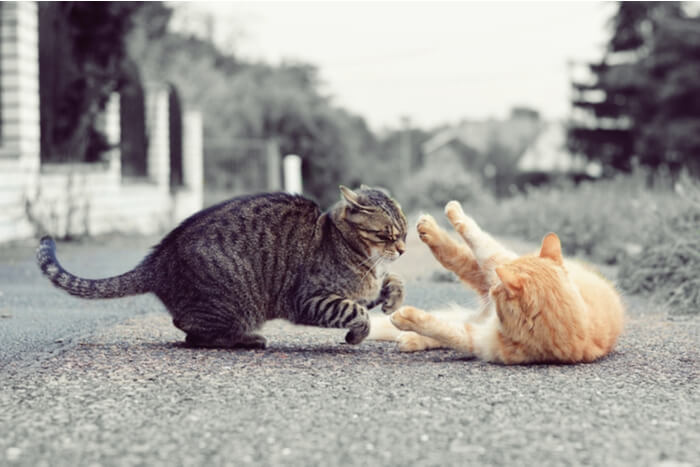
Most cats in affiliated social groups will engage in play fighting.
Play is important for all cats. Whether young or old, play has a positive impact on a cat’s emotional state while providing stimulation from boredom and helping to develop and maintain social bonds. Unlike dogs, who use play as a form of social interaction, the motivation for play in both kittens and adult cats is centered around predatory behavior. Play fighting among cats is normal and healthy behavior.
How Do Cats Play With Each Other?
Sibling cats commonly indulge in play sessions that include stalking, chasing, as well as pouncing. At times, these play sessions seem like fights. Some play sessions can lead to an individual cat becoming over-stimulated and boisterous, which can be stressful for a cat that is not as excitable. Keep a close eye on these situations when they arise, and diffuse tension to avoid escalation when one or both cats display signs of aggression.
Cats are prone to indulge in social play in the right type of environment. A play space could be full of fun obstacles, hiding holes, cat trees, activity centers, and boxes with entry/exit holes to name a few examples.
Cats communicate through body language and to a lesser extent through vocalization. The overall social relationship between cats should be considered when determining if they are displaying playing or fighting behavior since these expressions can also be individual.
Signs Your Cats Are Playing
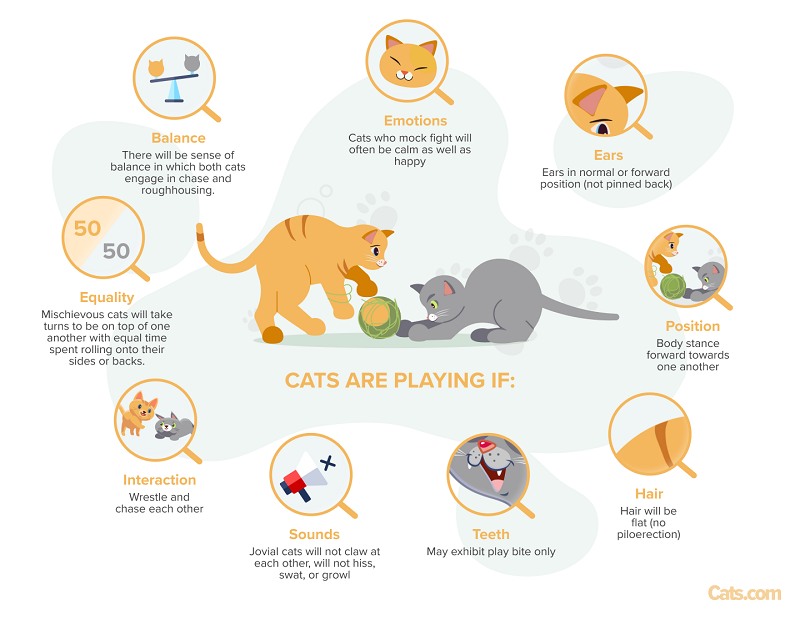
Kittens are very social and have a high play drive from an early age. They are taught skills such as grooming, feeding, and hunting by the queen and rely on collaborations with littermates to learn social skills.
Inter-cat social play peaks around 8-10 weeks of age, then object play becomes prevalent. Toys present an outlet for natural predatory sequences as part of play, which prevents play biting.
Cats can be playful into old age; however, cat interactions and social play may decline with maturity.
The following are indicators that your cats are playing:
- They remain calm and happy during the interaction.
- The ears are in a normal or forward position (not pinned back).
- The body stance is forward, facing one another.
- The fur is flat (no puffed-up tail or piloerection).
- They play bite only.
- They wrestle and chase each other.
- Jovial cats will not claw, hiss, swat, or growl at each other.
- There will be a sense of balance in which both cats engage in chasing and roughhousing.
In certain social groups, male cats can often engage in extra play fights in comparison to females, who are generally less interested in rowdiness after social maturity (around three years of age).
Signs Your Cats Are Fighting
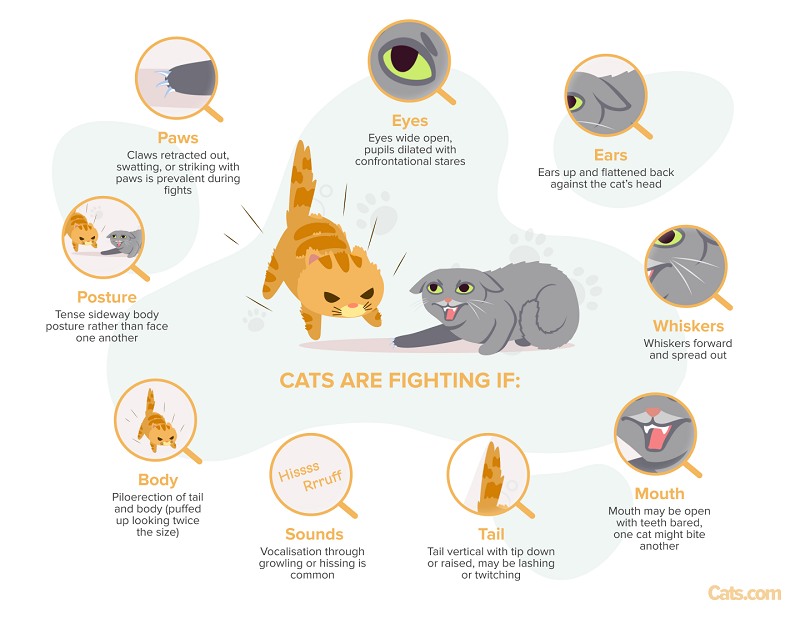
As a resourceful species, cats generally avoid physical disputes. Overt fighting can cause injury, incapacity of hunting, and even death.
Active aggression (fighting) will occur if the cat feels threatened, and avoidance prospects or escape are limited or absent.
Certain cats resort to fighting for a variety of reasons. Most cats will defend their territory (within the home or beyond) against invaders. Some cats turn to active aggression faster than others, dependent on individual genetics, sex, and early life experiences.
The following are signs that your cats are fighting:
- Their eyes are wide open and their pupils are dilated with confrontational stares.
- The ears are up and flattened back against the cat’s head.
- The whiskers are forward and spread out.
- The mouth is open with teeth bared.
- There is vocalization through growling or hissing.
- Piloerection of tail and body (puffed up, looking twice the size)
- Tense, sideways body posture rather than facing one another.
- The claws are out during swatting or striking.
- The tail is vertical with the tip down or raised, or it is lashing back and forth or twitching.
Cats cannot diffuse an aggressive situation due to limited social communication skills, so it is up to cat owners to help resolve it. It can take a couple of hours once aggression intensifies for a cat to calm down. Once separated, leave the cats alone, each in a quiet room, until they have fully relaxed.
Reasons Cat Fight
So, why do some cats fight more than others? Each cat is different, but there is a long list of factors that contribute to aggression in cats. Every situation requires a thoughtful approach to resolve while considering the individual cat’s unique circumstances. Here are the common reasons some cats fight more than others.
1. A Lack of Early-Life Socialization
The socialization period (2 – 9 weeks) is crucial for kittens. Hand-raised kittens that have not been socialized with other cats during this critical period are anecdotally at risk of developing problem behaviors such as nervousness, aggression, and reduced coping mechanisms during environmental changes.
2. New Household Members
In a 2017 study conducted with 2,492 owners of multiple cats, 73.3% noted aggression signs during the initial introduction phase of another cat. The addition of a new cat to the home correlated with the frequency of disputes and more cats in one household added recurrent tension signs.
3. Food and Resource Scarcity
Food aggression causes strife when cats from different social groups are fed in proximity and when food is scarce. Competition for resources or human attention also causes inter-cat friction.
4. Territorial Disputes
We often hear free-roaming felines fight due to a territorial disagreement, particularly at night. Cats place significant reliance on securing their territory, more so than on connections to people or other cats. Many problematic cat behaviors come from perceived threats to this security, often due to disputes with other felines.
5. Illness
Inter-cat conflict due to illness commonly presents as sudden attacks without previous disagreement between involved cats. If this occurs at your home, take your cat to the veterinarian to make sure they are healthy and thriving.
6. Protecting Kittens
Households with breeding females may also encounter episodes of aggression, especially when queens are safeguarding their kittens.
7. Genetics
Problematic cat behavior is also affected by several genes. One of them is the oxytocin receptor, which has been identified as contributing to irritability signifying that genetic testing may become an important tool in the veterinary behaviorist field.
What To Do if Your Cats Are Fighting
Inter-cat conflicts cause a lot of stress to both the resident cat(s) and their owner. When a fight occurs, do NOT place your hand or any body parts between fighting cats. Doing so can cause a major injury requiring urgent medical attention, because cat bite wounds tend to be deep, and cats harbor bacteria and other pathogens in their mouths.
The use of noise deterrents, spray bottles, and water guns are common ways that cat owners break up catfights. This, however, may be frightening for your cats and can have negative effects on an anxious cat. Never punish or touch a cat during these times, as it may cause the cat to become fearful of people.
Instead, throw a towel or small blanket on both cats to break up the fight. The goal is to distract and divert the cats’ attention.
Barrier separation, such as baby gates, cardboard, wood, or plastic boards are also useful tools to block the view of each cat.
When tensions have cooled, encourage contact through positive reinforcement. This can be achieved through separation, confinement, and gradual reintroductions.
How To Reduce Stress and Minimize Fights
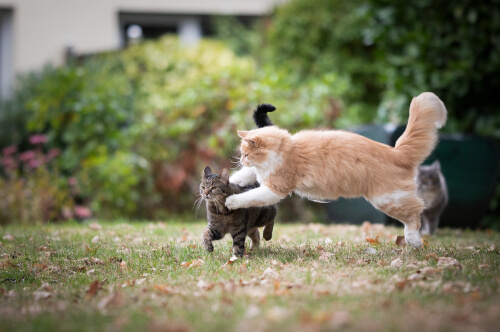
Neutering or spaying your cats will help address certain aggressive behaviors, particularly in intact males.
The best way to minimize fighting in a multi-cat household is to provide plenty of resources and enrichment opportunities to meet the needs of each cat. Environmental enrichment and multiple resources distributed around the house, such as litter boxes, beds, scratching posts, bowls, hiding spots, and perches will help to reduce stress and increase your cats’ ability to cope with disruptions.
Also Read: The 8 Best Cat Trees of 2024
Toys, puzzle feeders, foraging opportunities, and supervised outside time should be provided to all cats even if they have outdoor access. Extra enrichment should be offered to indoor cats, who can become bored and unhappy without the opportunity to indulge in hunting and exploration instincts that come with an outside environment.
Interactive personal play with each cat should be tailored to suit the individual cat. Play mimics predatory behavior for cats, so it helps to minimize play aggression.
Feliway may also help reduce inter-cat tension and habituation to a new home when used in combination with other anxiolytic products.
Neutering or spaying your cats will help address certain aggressive behaviors, particularly in intact males.
And finally, reinforcing friendly, playful interactions and taking steps to reduce aggressive behavior is reliant on the correct integration of a new cat and being aware of cat groups’ social dynamics in multi-cat homes.
If you are still unsure if your cats are playing or fighting, record their interaction and post it in the comments below, or show the video to your veterinarian or cat behaviorist.
Also Read: The 10 Best Cat Slow Feeders & Puzzle Feeders
-
Ashley L Elzerman, T. L.-F. (2019). Conflict and affiliative behavior frequency between cats in multi-cat households: a survey-based study. Journal of Feline Medicine and Surgery, 22(8), 705-717. Retrieved September 20, 2020, from https://journals.sagepub.com/doi/10.1177/1098612X19877988
-
Bradshaw, J. (2018). Normal feliNe behaviour and why problem behaviours develop. Journal of Feline Medicine and Surgery, 20, 411-421. Retrieved September 23, 2020
-
Care, I. C. (2018, September 26). Aggression between cats. Retrieved September 28, 2020, from International Cat Care: https://icatcare.org/advice/aggression-between-cats/
-
Halls, V. (2013, August). The feline fun factor – does play matter? UK. Retrieved September 27, 2020, from http://www.vickyhalls.net/free-guides
-
Heath, I. R. (2016). Feline Behavioral Health and Welfare. St Louis, MO: Elsevier. Retrieved September 26, 2020
-
Minori Arahori, *. Y.-M. (2015). The oxytocin receptor gene (OXTR) polymorphism in cats (Felis catus) is associated with “Roughness” assessed by owners. Journal of Veterinary Behavior, 1-4. Retrieved September 25, 2020, from 10.1016/j.jveb.2015.07.039
-
Ramos, D. (2019). Common Feline Problem Behaviours Aggression in multi-cat households. Journal of Feline Medicine and Surgery, 21, 221-233. Retrieved September 24, 2020
-
Sharon L. Crowell-Davis*, T. M. (2004). Social organization in the cat: a modern understanding. Journal of Feline Medicine and Surgery, 6, 19-28. Retrieved September 22, 2020, from https://www.elsevier.com/locate/jfms
-
States, T. H. (2019). Guide to Cat Behaviour Counselling. Washington, DC, USA: The Humane Society Of The United States. Retrieved September 28, 2020

